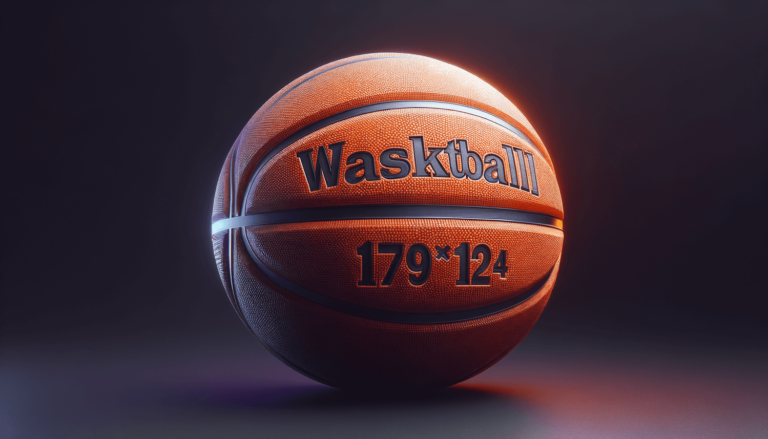
Have you ever held a basketball and wondered how much it actually weighs? Or have you simply been curious about the dynamics of the game? If so, this blog post is just right for you! Get ready to have your curiosity satisfied as we explore the weight of a basketball in pounds, unravel its standard measurements, and discover how these factors impact the game on the court. So lace up your sneakers, put on your game face, and let’s dive into the fascinating world of basketball as we answer the age-old question: “How much does a basketball weigh in pounds?”
How Much Does a Basketball Weigh in Pounds?
A basketball typically weighs around 1.1 pounds (approx. 22 ounces) for a men’s official size 7, while a women’s official size 6 basketball weighs about 20 ounces (1.25 pounds). Different age groups and competition levels may use varying ball sizes and weights, but these measurements are standard for professional play.
The Significance of Basketball Weight in the Game
Understanding the importance of a basketball’s weight is essential to get the most out of every game session. A basketball’s size and weight affect various aspects of the game, such as ball control, shooting, dribbling, and passing. Let’s dive into the significance of basketball weight in different scenarios so you can have the best time on the court!
Ball Control
Depending on the weight of a basketball, players may find it easier or more challenging to control the ball during the game. A heavier basketball typically requires more strength and skill to grip and control, while lighter basketballs are easier to handle, especially for younger players or those with smaller hands. Playing with a ball of appropriate weight helps improve ball control and enhances overall gameplay.
Shooting and Scoring
A basketball’s weight plays a crucial role in shooting accurately, as it dramatically impacts your shooting range and arc. Heavier balls require more effort to shoot, affecting the player’s shooting form and accuracy when attempting to score. Lighter basketballs are generally easier to shoot; however, selecting a ball with the appropriate weight for the player’s skill and strength level is important to balance this aspect of the game.
Dribbling
The basketball’s weight concerns not only how it feels in your hands, but also how it interacts with the court. Lighter basketballs tend to have a higher bounce, while heavier basketballs require more effort to dribble effectively. Therefore, consider the weight of a basketball when developing your dribbling techniques and practice routines to optimize your ball-handling skills.
Passing and Receiving
Accurate passing requires a good feel for the basketball’s weight, as well as the balance and control it demands. A ball that is too heavy or too light might affect the player’s ability to pass effectively or receive passes without losing control. Players need to get familiar with the weight of the basketball to improve their passing and receiving skills in game situations.
Weight and Size Standards for Different Age Groups and Leagues
As we’ve established, not all basketballs weigh the same. Basketball players compete in various age groups and leagues, each with specific weight and size requirements. By understanding these different standards, you can select the appropriate basketball for your particular age group, gender, or competition level.
Size 7: Men’s Official Basketball
An official men’s game-size basketball, known as size 7, is used in high school, college, and professional men’s play. This basketball measures approximately 29.5 inches in circumference and weighs around 1.1 pounds (22 ounces). The use of size 7 basketballs is sanctioned by the National Federation of State High School Associations (NFHS), the National Collegiate Athletic Association (NCAA), and the National Basketball Association (NBA).
Size 6: Women’s Official Basketball
The size 6 basketball is considered the official women’s basketball for high school, college, and professional play. It has a slightly smaller circumference of 28.5 inches and weighs approximately 1.25 pounds (20 ounces). It is the preferred basketball size for female athletes and is endorsed by organizations such as the Women’s National Basketball Association (WNBA) and the International Basketball Federation (FIBA).
Size 5: Youth Basketball
Size 5 basketballs are designed for players between the ages of 9 and 11. These basketballs weigh approximately 18 ounces (1.125 pounds) and have a circumference of 27.5 inches. The use of size 5 basketballs allows youth players to develop their skills and adjust to the game’s weight requirements at a more manageable level.
Size 4: Junior Basketball
Junior basketballs, also known as size 4 basketballs, cater to players between the ages of 5 and 8. These basketballs weigh about 14 ounces (0.875 pounds) and have a circumference of 25.5 inches. Ideal for young players learning the game, size 4 basketballs make it easier for budding athletes to develop fundamental skills without the burden of handling a heavier ball.
Material and Construction Impact on Basketball Weight
Another important factor contributing to a basketball’s weight is the material used to construct the ball. Basketballs come in a variety of materials, each with unique properties and benefits. The type of material used in a basketball can impact its weight, grip, feel, and durability.
Leather Basketballs
Leather basketballs are the preferred choice for professional leagues such as the NBA. These basketballs are constructed using genuine leather, making them the most expensive option. A leather basketball offers an outstanding grip and exceptional feel on the court. As it breaks in, the basketball softens, providing an even better playing experience. However, leather basketballs should primarily be used indoors, as rough outdoor surfaces can damage the ball and reduce its lifespan.
Composite Leather Basketballs
Composite leather basketballs, made from synthetic leather or a blend of genuine and synthetic leather, are popular among players at various levels, including college and high school. Composite leather basketballs tend to offer a similar feel and grip as genuine leather balls, but at a more affordable price. An advantage of composite leather basketballs is that they are suitable for both indoor and outdoor play, making them a versatile choice for athletes who want a high-quality ball with greater durability.
Rubber Basketballs
Rubber basketballs are generally the least expensive option and are perfect for outdoor play. Constructed with a tough rubber exterior, these basketballs can withstand harsh outdoor surfaces and weather conditions. However, rubber basketballs may feel slightly heavier and tend to have a less consistent bounce compared to leather or composite leather basketballs. Nevertheless, rubber basketballs are an excellent choice for casual players or those just starting to learn the game.
Tips for Choosing the Right Basketball Weight and Size
Now that we’ve delved into the various basketball weights and sizes, as well as the materials used in their construction, it’s time to use this newfound knowledge to choose the right basketball. Here are some tips to help you find the perfect basketball to enhance your gameplay:
Consider Your Age and Gender
A player’s age and gender play a significant role in determining the appropriate basketball weight and size. Make sure to select a basketball that is suitable for your specific age group and gender, as using an inappropriate ball can negatively impact your development and gameplay.
Indoor or Outdoor Use
Consider where you will primarily use the basketball, whether indoors or outdoors. If you frequently play on rough outdoor surfaces, opt for a rubber basketball or a composite leather basketball designed for both indoor and outdoor use. If you plan to play indoors, a leather or composite leather basketball can provide the best grip and longevity.
Match Your Skill Level
Choose a basketball that complements your skill level in the game. For beginner and intermediate players, a rubber or composite leather basketball can offer a good balance of grip, durability, and affordability. Advanced players may prefer the superior feel and grip of a genuine leather basketball, especially if they play predominantly indoors.
Maintain the Weight of Your Basketball
Proper maintenance of your basketball can significantly impact its weight, longevity, and overall performance. Here are some practical tips to help you take care of your basketball and ensure it remains in optimal condition:
Correct Inflation
Maintaining the appropriate inflation level in a basketball is crucial for optimal performance. Underinflated basketballs may feel heavy or sluggish, while overinflated balls may bounce erratically and compromise your control. Use an air pressure gauge to measure the basketball’s pressure, and follow the manufacturer’s recommended inflation range, typically between 7.5 and 8.5 pounds per square inch (PSI).
Clean Regularly
A clean basketball not only looks better but also helps maintain the ball’s weight and surface quality. Wipe down your basketball using a damp cloth to remove dirt, dust, and residue after each use. Doing so not only keeps the ball clean but also prolongs its lifespan by preventing material deterioration.
Proper Storage
Properly storing your basketball when not in use can help preserve its weight and structural integrity. Avoid exposing the ball to extreme temperatures or direct sunlight, as these conditions can negatively affect the basketball’s weight, bounce, and material. Instead, store your basketball in a cool, dry place away from direct sunlight.
Conclusion
By understanding the weight of basketballs and their impact on various aspects of the game, you can make an informed decision when choosing the right ball for your needs. By selecting the appropriate basketball size, weight, and material, you can enhance your skills and enjoy an optimal gameplay experience. So now that you know how much a basketball weighs, it’s time to hit the court and make those game-winning plays!
Choosing the Right Basketball for You
With all the options available for basketball sizes, weights, and materials, you might be wondering what’s the most essential factor when choosing a basketball: personal comfort. Ultimately, the right basketball for you will feel comfortable in your hands and complement your style of play.
Testing Different Basketballs
Before committing to a specific basketball, try playing with different balls to better understand what feels best for you. Ideally, borrow or test out different basketballs from friends, teammates, or local sports stores. Pay attention to the size, weight, and material of each basketball, and note which one best suits your preferences and gameplay.
Familiarize Yourself with the Basketball
No matter which basketball you choose, it’s essential to become familiar with it to perform your best on the court. Spend time dribbling, shooting, and passing the basketball to build confidence and improve your skills. Remember, practice makes perfect, so the more comfortable you are with your basketball, the better you’ll perform during games.
Regulation Size and Weight for International Play
While we’ve covered the standard sizes and weights for basketballs used in various leagues and age groups, international competitions have specific guidelines to ensure consistency in gameplay. These guidelines are set by the International Basketball Federation (FIBA), which governs international basketball competitions, including the Olympics.
FIBA Men’s Official Basketball Size and Weight
For international men’s competitions, FIBA mandates the use of size 7 basketballs, which have a circumference of 29.5 inches (75 cm) and weigh between 1.4 ounces (600 g) and 1.2 pounds (650 g).
FIBA Women’s Official Basketball Size and Weight
In international women’s competitions, FIBA enforces the use of size 6 basketballs. These basketballs have a circumference of 28.5 inches (72 cm) and weigh between 1.1 pounds (510 g) and 1.3 pounds (567 g).
FIBA Youth Basketball Size and Weight
FIBA uses size 5 basketballs for international youth competitions. These basketballs have a circumference of 27.5 inches (69.5 cm) and weigh between 17.6 ounces (500 g) and 1.1 pounds (540 g).
How Air Pressure Affects Basketball Weight
As mentioned earlier, maintaining the correct air pressure is crucial for your basketball’s performance. However, it’s worth noting how the air pressure affects a basketball’s weight. When a basketball is underinflated, it may feel heavier, impacting your ability to dribble, pass, and shoot accurately. Overinflated basketballs, on the other hand, may feel lighter and bounce erratically, making it challenging to control the ball during gameplay. Ensuring proper inflation can help maintain the ideal weight for your basketball and improve your performance on the court.
Adapting to Changes in Basketball Weight
As players grow and improve their skills, it’s essential to be open to changes in basketball weight. Transitioning from a lighter basketball to the standard size and weight used in high school, college, or professional play may take some time and practice. To comfortably adapt to the change in basketball weight, gradually increase your practice time with the new ball, focusing on ball control, dribbling, shooting, and passing. By consistently practicing with the heavier basketball, you’ll become more familiar with its weight and develop the strength and skill to perform well with it.
Final Thoughts
Understanding the weight of a basketball is a vital aspect of the game, as it impacts ball control, shooting, dribbling, and passing. By knowing how much a basketball weighs and considering factors such as age, gender, skill level, and playing preferences, you can choose the right basketball for your needs. Incorporating proper maintenance and adapting to changes in basketball weight will further enhance your performance and overall enjoyment of the game. Keep these factors in mind, and you’ll be well on your way to achieving success on the court!
Frequently Asked Questions
In this section, you’ll find answers to some of the most commonly asked questions related to basketball weight, sizes, and more. These simple and concise answers are designed to help you quickly address any lingering questions and further enhance your understanding of the subject.
1. What is the official NBA basketball weight?
The official NBA basketball, a men’s size 7, weighs approximately 1.1 pounds (22 ounces).
2. What is the weight of a WNBA basketball?
The Women’s National Basketball Association (WNBA) uses size 6 basketballs, which weigh about 1.25 pounds (20 ounces).
3. Do different leagues use different basketball weights?
Yes, different leagues and age groups use varying basketball sizes and weights to accommodate players’ physical capabilities and skill levels.
4. Can a heavier basketball improve my shooting range?
Practicing with a slightly heavier basketball can help build strength and potentially improve your shooting range. However, it’s essential to balance practice time between your regular game ball and a heavier ball to maintain consistency in your shooting form and accuracy.
5. Are youth and junior basketballs lighter?
Yes, youth (size 5) and junior (size 4) basketballs are lighter than the standard men’s or women’s basketballs, making them more manageable for younger players.
6. Will the weight of the basketball affect dribbling skills?
The basketball’s weight can impact dribbling skills, as heavier basketballs require more effort to dribble effectively and may have a varied bounce compared to lighter basketballs.
7. Are leather basketballs the heaviest?
Not necessarily. Basketball weight is determined more by its size and air pressure than the material used. However, leather basketballs may feel slightly heavier due to their solid construction and premium materials.
8. Can I use the same basketball for both indoor and outdoor play?
Yes, you can use the same basketball for both indoor and outdoor play. However, it’s crucial to choose a basketball made from appropriate materials for multi-environment use, such as composite leather or rubber basketballs.
9. Can I use a heavier basketball to build strength?
Yes, practicing with a heavier basketball can help build arm and wrist strength, which may improve your ball control, shooting, and passing. Just remember to balance your practice between the heavier ball and your game ball.
10. How can I maintain the weight of my basketball?
To maintain the weight of your basketball, ensure proper inflation, clean it regularly, and store it in a cool, dry place away from direct sunlight.
11. Do all basketballs weigh the same when inflated?
No, basketballs of different sizes and materials may have slight weight differences, even when inflated to the same air pressure.
12. Should I choose a basketball based on its weight?
While the weight of a basketball is essential, it is just one factor to consider. You should also take into account factors like size, material, playing location, and personal comfort.
13. Is there a difference in weight between indoor and outdoor basketballs?
Generally, there is no significant difference in weight between indoor and outdoor basketballs. However, due to the materials used, outdoor basketballs may feel slightly heavier or have a different bounce compared to indoor basketballs.
Featured Posts
- No pillar pages found.





